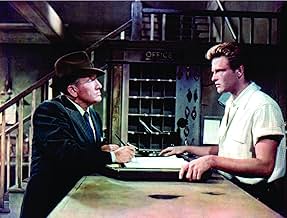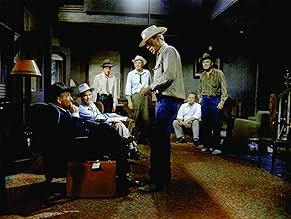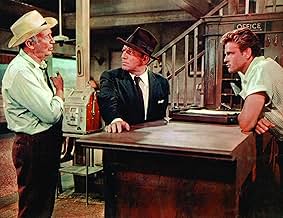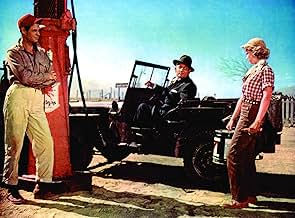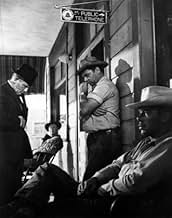Following World War II, a one-armed stranger arrives in a tiny California desert town, but finds the residents hostile and protecting a terrible secret they want to keep hidden, by violent m... Read allFollowing World War II, a one-armed stranger arrives in a tiny California desert town, but finds the residents hostile and protecting a terrible secret they want to keep hidden, by violent means if necessary.Following World War II, a one-armed stranger arrives in a tiny California desert town, but finds the residents hostile and protecting a terrible secret they want to keep hidden, by violent means if necessary.
- Director
- Writers
- Stars
- Nominated for 3 Oscars
- 4 wins & 8 nominations total
- Cafe Lounger
- (unconfirmed)
- Cafe Lounger
- (unconfirmed)
- Cafe Lounger
- (unconfirmed)
- Cafe Lounger
- (unconfirmed)
- Second Train Conductor
- (uncredited)
- First Train Conductor
- (uncredited)
- One of Two Porters
- (uncredited)
- Tall - White-haired Cafe Lounger
- (uncredited)
- Director
- Writers
- All cast & crew
- Production, box office & more at IMDbPro
Featured reviews
I read a review of the film on IMDB pointing out the flaws in the script. They are all correct, if we go by rational thinking. But the merits of this film are the superb editing, the beautiful cinemascope photography and the arresting performances. Every time I see this film I am reminded of Spielberg's little known film "Duel" that had similar thrilling tension packed into less than 24 hours of screen time--a film I admire much more as good cinema than the recent box office outputs of Spielberg.
Compare this film with Sturges' "The Magnificent Seven." Sturges like King Vidor, seemed to pick up stories to film that looked at the oppressed and tried to present a world that could be better. "The Magnificent Seven," like this film, had a predominantly male cast. It appealed to most viewers. And some could see a social and even a political layer beneath these films.
What I find most appealing is the the ability of Sturges, Vidor, and the early unsung Spielberg's ability to use cinema to combine thrills, human values and craft in say 81 minutes as in this film. Spencer Tracy is not to be admired for the way he delivers his lines, but his body movements which remind you of majestic caged animal that can be deadly if provoked. Sturges brings to the fore evil in different ways--the dead buck strapped on the front of a vehicle, menace on empty roads by big vehicles (used in "Duel" to great effect), evil women when you expect them to be good, laws used in illegal ways (the hotel registration scene), etc. Sergio Leone made similar films in Europe--the famous spaghetti westerns--with laconic dialogues and emphasis on body movements and photography
In spite of its flaws, it is a film Hollywood can be proud of. I only hope TV reruns show the film in its original cinemascope grandeur, which grabbed me the first time I saw it decades ago.
Unity of place:everything takes place in a one-horse town,Black Rock,where an unusually inventive use of the wide screen makes the small town even more isolated,cut off from the world.When you leave Black Rock,you find a desolate landscape where only some flowers (of death?as Tracy points out)grow.
Unity of action:something happened in "Black Rock" ,something that its inhabitants are anxious that it remains in the shadow.Enter Tracy who seems to know too many things he should.Then all the inhabitants all stand together ,and their conspiracy of silence becomes threatening.What's amazing is that John Sturges (it's probably his best film,he uses Tracy in a much better way than he did in "people against o'Hara" some years before)refuses the easy way out:take for instance the only female character played by Anne Francis ;she does not act as the audience expects .Stand-out remains Robert Ryan,always excellent in one of his villains parts:funny how an actor who was known for his liberal views should have played so many racists ,anti-Semitics (this film,but also Dmytryk's "crossfire" and Wise's "against all odds").Other good performances come from Marvin and Borgnine.
Unity of time:everything happens in the space of 24 hours;first sequence :the train arrives in Black Rock,last sequence:it leaves it.
This is a modern western,which takes place just after WW2."Bad Day at Black Rock" is also,in its own special way, a war movie ,and also an anti-war one,because Tracy's life was saved by a...
Thoroughly enjoyable ,it deserves its reputation of classic.
John Sturges has done a wonderful job of bringing all of these elements together. One of the things that I found interesting was that there were very few, if any, close-ups. Most of the shots could have been master shots. For me, this made me feel as though I were a by-stander in the room with the characters while they talked. A nice touch.
As expected all of the performances are great. Tracy, Ryan, Brennan, and Jagger are all terrific. As are Lee Marvin and Ernest Borgnine (two actors at the time who were about to break out, and become top-line stars).
If you like classic westerns, and great acting, "Bad Day at Black Rock" will not disappoint.
8 out of 10
Most people will tell you this film is famous because it was one of the first times an American film acknowledged that, after Pearl Harbour, oriental Americans were abused and treated badly. However to me this film is a damnation to those who stand back and refuse to take a stand against wrong doing. The whole plot is hinged on whether or not people ill stand up and do the right thing with Macreedy. The film plays well as a moral fable but also as a tense thriller and both are enjoyable.
The film is quite short, but builds well from hostile locals to eventual violence and confrontation in the desert. The moral of taking a stand is weaved into it well without taking away from the main drama and tension. It isn't perfect as it is a bit simplified but in the desert heat of the small town the tension is really well recreated.
The cast is surprisingly deep in hindsight. Tracy is manners himself as the man who gets more irate by the apathy around him as he gets to uncover more and more of the town. Ryan is cool but a little too inhuman for my tastes. Jagger and Brennan are suitably trapped in their performances and represent those happy to watch bad things happen if they get a quiet life. In retrospect Borgnine and Marvin add star power and do well with what could have been just thug/heavy roles.
Overall this film worked for me on several levels. The heat of the desert adds to the tension in the actual drama story itself. However it also works as a moral fable with a very clear message stand up for what is right or watch what you believe slip away at an alarming rate.
Did you know
- TriviaJohn Sturges had already moved on to his next film, Duel d'espions (1955), so Herman Hoffman took charge of filming the opening. The plan was to shoot the train hurtling toward the audience, almost like a 3-D movie, but it would have been deadly to attempt a helicopter maneuver into the path of a speeding locomotive. Stunt flier Paul Mantz offered the perfect solution: have the train running backwards, fly the copter over the retreating engine, then project the footage in reverse. "It's a helluva shot," Sturges later said, "but I didn't make it."
- GoofsAs the train approaches the town, the horn blows twice, which is the signal for starting up. The mandatory signal for a grade crossing (long, long, short, long) is never blown, although one clearly exists. When the train departs, the conductor makes a confused hand signal to the engineer resembling the horizontal motion that means "stop" rather than the vertical motion that means "go". The engineer never responds with the "long, long" starting signal.
- Quotes
Reno Smith: I swear, you're beginning to make me mad.
John J. Macreedy: All strangers do, hmm?
Reno Smith: No, they don't. Not all of them. Some do, when they come around snooping...
John J. Macreedy: Snooping for what?
Reno Smith: I don't know, outsiders coming in, looking for something...
John J. Macreedy: Looking for what?
Reno Smith: I don't know! Somebody's always looking for something in this part of the West. To the historian it's the Old West, to the book writer it's the Wild West, to the businessman it's the Undeveloped West -- they say we're all poor and backward, and I guess we are, we don't even have enough water. But to us, this place is *our* West, and I wish they'd leave us alone!
John J. Macreedy: Leave you alone to do what?
Reno Smith: I don't know what you mean.
- Alternate versionsTo receive an 'A' (PG) certificate in 1955 the UK cinema version was subject to heavy BBFC cuts. These included Macreedy striking Hector with the brass fire hose nozzle and the climactic shots of Reno on fire. Later TV showings and video releases were fully uncut.
- ConnectionsFeatured in The Spencer Tracy Legacy: A Tribute by Katharine Hepburn (1986)
Details
Box office
- Budget
- $1,271,000 (estimated)
- Gross worldwide
- $10,813
- Runtime1 hour 21 minutes
- Color
- Aspect ratio
- 2.35 : 1
Contribute to this page



